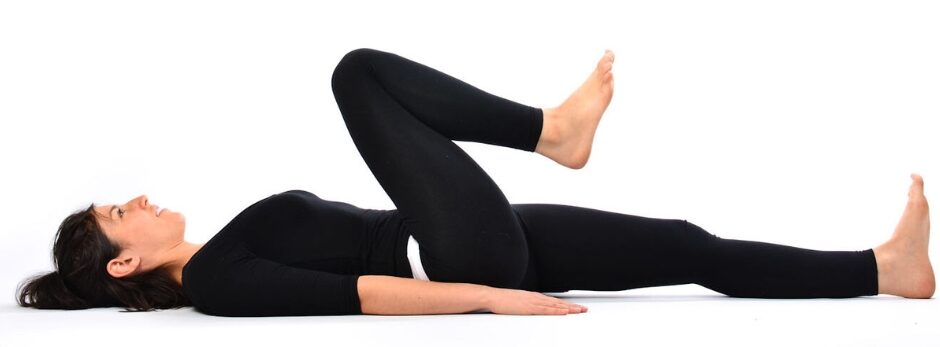Pada Sanchalanasana, or Leg Cycling, is a dynamic yoga pose from the Hatha Yoga Pawanmuktasana series that brings vitality to your practice. In Sanskrit, “Pada” means leg, and “Sanchalanasana” translates to cycling. This asana involves cyclic movements of the legs, offering a unique blend of flexibility and strength. Let’s delve into the details of Pada Sanchalanasana (Leg-Cycling) and discover its instructions, benefits, and essential precautions.
What is Pada Sanchalanasana ?
Pada Sanchalanasana (Leg-Cycling) is a leg-centric pose where you mimic the motion of cycling. It combines the benefits of stretching and controlled movement, promoting agility and coordination. The cyclical nature of the pose energizes the lower body and enhances blood circulation

Step-By-Step Instructions of Pada Sanchalanasana (Leg-Cycling)
Pada Sanchalanasana, or Leg Cycling Pose, invites you into a rhythmic flow that intertwines breath, movement, and mindfulness. Here’s a simple guide to help you seamlessly perform this dynamic yoga asana:
- Start in a Comfortable Seated Position: Begin by finding a serene space on your yoga mat. Sit comfortably with an erect spine, allowing your breath to settle and grounding yourself in the present moment.
- Lift One Leg at a Time: Gradually lift one leg, bringing the knee toward your chest. Feel the engagement in your core muscles as you maintain a tall spine.
- Initiate the Cycling Motion: Extend the lifted leg forward, initiating a cycling motion. Imagine your foot tracing a circular path, embracing the fluidity of the movement.
- Coordinate with Breathing: Sync your leg movements with your breath. Inhale as the leg moves up, and exhale as it descends. This coordination enhances the flow and meditative quality of the pose.
- Explore Both Legs: After several cycles, switch to the opposite leg. Feel the extension and contraction of your muscles, fostering a sense of balance and symmetry.
- Maintain Gentle and Controlled Movements: Focus on maintaining a gentle and controlled pace. Avoid abrupt movements, allowing the cyclical motion to unfold naturally.
- Gradual Relaxation: As you conclude the practice, gradually release both legs to the ground. Close your eyes, breathe deeply, and sense the subtle reverberations of energy throughout your body.
Benefits of Pada Sanchalanasana (Leg-Cycling)
- Enhanced Flexibility and Joint Mobility: Pada Sanchalanasana‘s cyclic leg movements actively engage the hip and knee joints, promoting flexibility and enhancing the range of motion. This contributes to improved joint health and overall flexibility.
- Strengthened Abdominal and Core Muscles: The rhythmic cycling action requires continuous core engagement, effectively toning and strengthening the abdominal muscles. This, in turn, supports better posture and enhances overall core stability.
- Boosted Blood Circulation: The dynamic nature of Pada Sanchalanasana (Leg-Cycling) stimulates blood circulation throughout the lower extremities. This increased blood flow delivers oxygen and nutrients to the muscles, promoting vitality and a sense of rejuvenation.
- Revitalized Digestive System: Pada Sanchalanasana (Leg-Cycling) provides a gentle massage to the abdominal organs, particularly the digestive system. This can help alleviate common digestive issues, enhance bowel movements, and contribute to a healthier gut.
- Calming and Stress Reduction: The meditative quality of the leg cycling motion, coupled with synchronized breathing, induces a sense of calmness. Pada Sanchalanasana serves as a therapeutic practice, reducing stress and promoting mental relaxation.
- Balancing Energy Centers: This pose harmonizes the Svadhishthana (Sacral) and Manipura (Solar Plexus) Chakras. The cyclical leg movements activate these energy centers, fostering creativity, emotional balance, and a sense of personal power.
- Improved Focus and Concentration: Practicing Pada Sanchalanasana (Leg-Cycling) with mindfulness enhances focus and concentration. The intentional coordination of breath and movement sharpens mental awareness, cultivating a centered and present state of mind.
- Promotion of Mind-Body Connection: Pada Sanchalanasana (Leg-Cycling) encourages a deep connection between mind and body. The synchronized flow of the pose instills a sense of unity, promoting holistic well-being and self-awareness.
Incorporate Pada Sanchalanasana (Leg-Cycling) into your regular yoga practice, and embrace the holistic benefits it offers for your physical health and mental harmony.
Traditional Context of Pada Sanchalanasana (Leg-Cycling)
In the traditional context, Pada Sanchalanasana (Leg-Cycling) is associated with promoting vitality and dynamism. It aligns with the yogic principle of energizing the body to facilitate a deeper connection with the breath and inner self.
At its core, Pada Sanchalanasana (Leg-Cycling) aligns with the foundational principles of Hatha Yoga, emphasizing the balance of opposing forces. The cyclic motion mirrors the ebb and flow of life, symbolizing the cyclical nature of existence and the continuous journey towards harmony. In yogic philosophy, the legs represent grounding and stability, connecting the practitioner with the Earth’s energy.
Furthermore, Pada Sanchalanasana is associated with the activation of Svadhishthana Chakra, located at the sacral region. This chakra is linked to creativity, emotions, and the flow of life force energy. The cyclic leg movements stimulate this energy center, facilitating a harmonious expression of emotions and creative potential.
Cautions and Contra-indications of Pada Sanchalanasana (Leg-Cycling)
- Avoid Strain: If you feel strain in your lower back, reduce the speed or range of leg movements. You may also place your hands underneath your lower back or buttocks to relieve any strain.
- Injury Precaution: Individuals with knee or hip injuries should practice with caution and consult a yoga instructor or healthcare professional.
- Pregnancy: Pregnant practitioners should avoid Pada Sanchalanasana (Leg-Cycling) as the pressure on the back causes lower blood supply to the fetus.
Pada Sanchalanasana (Leg-Cycling) unfolds as a rejuvenating addition to your yoga repertoire, infusing a rhythmic flow into your practice. The cyclic leg movements not only strengthen and tone muscles but also offer a delightful cardiovascular boost. This accessible pose is adaptable for practitioners of various levels, allowing for personalized adjustments. In the rich tapestry of yoga, Pada Sanchalanasana (Leg-Cycling) weaves a thread of dynamism and mindful movement, inviting practitioners to experience the joy of a rhythmic, flowing practice that harmonizes both body and mind. Embrace the gentle revolutions of Leg Cycling, and let it become a soothing rhythm in your yoga journey.
The Importance of Practising Asana with an Experienced Teacher
The significance of practicing asanas under the guidance of an experienced teacher cannot be overstated. An experienced teacher brings a wealth of knowledge, offering insights into proper alignment, modifications, and the nuanced benefits and cautions associated with each pose. This personalized guidance ensures a safe and effective practice, preventing potential injuries and fostering a deeper understanding of the yogic postures. Embarking on the transformative journey of Yoga India Foundation’s 200 Hour Yoga Teacher Training in India provides an unparalleled opportunity to learn the intricacies of asana practice comprehensively. With seasoned instructors, the program delves into the A to Z of yoga asanas, equipping participants with the skills to teach and practice with confidence and proficiency.
